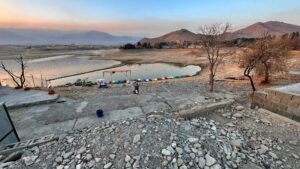China’s Growing Military Might and American Rashness
The U.S. can pursue one of two courses in East Asia: Either negotiate an understanding with regional powers and redeploy American troops, or continue the dangerous drift that provokes China's insecurities.Robert Gates’ official visit to Beijing, probably the last before he leaves the office of U.S. secretary of defense, was a frustrating affair, distinguished by China’s reiteration of its warnings that Washington must not sell arms to Taiwan, a demand that the United States has never accepted.
The Chinese enlivened Mr. Gates’ visit with a display of their new J-20 fighter, which is claimed to be stealthy and to have other advanced features that put it in the same category as the American F-22, except that the Chinese plane is still in flight development and will not be operational for years — unless the Chinese aerospace industry is a great deal more efficient than the American. Nonetheless, it provided a subject for the defense secretary’s reflection — and gained much attention in the aerospace press.
Members of the European Union have been considering an end to or modification of the European refusal to sell arms to China, a ban imposed at the time of the Chinese government’s repression of the Tiananmen Square political protests in 1989. Catherine Ashton, high representative of the EU for foreign affairs and security policy, issued a policy paper in December that described the embargo as “a major impediment for [surely she meant ‘to’] developing stronger EU-China cooperation on foreign policy and security measures.” She recommended discussion to “design a way forward,” a suggestion unpleasing to those Americans who anticipate a Chinese-American struggle to dominate East Asia, which too many do.
As I noted in a recent column, even some “realist” political scholars — opponents of the Iraq and Afghanistan interventions — believe that the U.S. must (permanently?) dominate the world’s principal centers of power: East Asia (meaning China), the Middle East extending to South Asia, and Western Europe. European arms sales to China would thus constitute an enlarged challenge to the American position from two of these three centers. The third — the Middle East and Central/South Asia — matters mainly by virtue of its natural resources. The last 10 years of increasingly aggressive American efforts to control this region have seriously backfired in Iraq (now virtually an Iranian satellite) and Afghanistan, and now look very much like they are producing disastrous consequences in Pakistan. (The markets think, or hope, that North American shale oil may take the place of Middle Eastern oil.)
This puts the U.S. on the defensive. The National Defense Strategy statements irregularly published during the past two decades have not emphasized national defense per se but the threat of denial of access to some areas — actual or potential political, military or technological obstacles to American forces’ ability to go wherever they want to go, and attack whatever they want to attack, preferably on the other side of the globe, where it is hardest for an opponent to strike back. The strategy statements’ main concern has been that American forces might be barred access to somewhere they are ordered to go in order to attack some potential threat to America’s global position.
This was apparent in the curious formulation of American military concern about Chinese military developments that Secretary Gates used while he was in Beijing. He said, “they clearly have the potential to put some of our capabilities at risk, and we have to pay attention to them.” This means that Chinese missile, air and submarine or surface naval forces increasingly seem able to defend China’s claims to Taiwan and in the Yellow and South China Seas, areas that the U.S. considers international waters.
There has for some years been considerable careless talk in Washington about future conflict with China. This is a possibility that has to be taken seriously if the U.S. is committed, as proposed, to military domination of East and Northeastern Asia.
The present military situation is the legacy of the Second World War (and the Korean War). The U.S. ended with a big base structure, and because of the postwar Japanese constitutional reform, including a national commitment to pacifism, Washington gave a formal assurance that it would provide Japan with permanent security. This is a serious commitment. However, it could be provided in ways other than by huge Marine bases on Okinawa (which are not specifically dedicated to Japan’s security, but are part of the American global base system), and by U.S. troops and airbases in Japan and South Korea.
There are two possible policy courses. The first is an early attempt to obtain multiparty negotiations to establish a joint East Asian security system underwritten by the U.S., China, Japan, Taiwan and Korea (or the Koreas). This is consistent with Chinese, Japanese and American (and for that matter Russian) national interests, even if it does not include final resolution of the Taiwan situation and China’s territorial claims. It could, depending on what it accomplishes, allow, or require, a substantial American redeployment of its forces back to Pacific bases or to the U.S. itself. The question to Americans is whether this is something that their government would accept.
The easy but extremely dangerous alternative is drift: to continue the existing arms competition, and the pursuit of existing territorial claims and rivalries. This will provoke China’s insecurities and vulnerabilities, and encourage American rashness.
The first way is better.
Visit William Pfaff’s website for more on his latest book, “The Irony of Manifest Destiny: The Tragedy of America’s Foreign Policy” (Walker & Co., $25), at www.williampfaff.com.
© 2011 Tribune Media Services Inc.
Your support matters…Independent journalism is under threat and overshadowed by heavily funded mainstream media.
You can help level the playing field. Become a member.
Your tax-deductible contribution keeps us digging beneath the headlines to give you thought-provoking, investigative reporting and analysis that unearths what's really happening- without compromise.
Give today to support our courageous, independent journalists.






You need to be a supporter to comment.
There are currently no responses to this article.
Be the first to respond.